
A Story of Mississippi’s Seafood Industry
![]()
![]() The Mississippi Croatian Story: Overcoming Adversity
The Mississippi Croatian Story: Overcoming Adversity
By Kat Bergeron
Sun Herald, South Mississippi’s News Leader
(Reprinted with permission from the April 27, 2014 issue)
The Croatians of the Mississippi Coast love to tell the story of Nikola Skrmetta, who immigrated from the Dalmatian Coast in the late 1890s. Biloxi was growing strong seafood legs, in need of workers to harvest and can oysters and shrimp. With a legendary strength of 10 men, he went to work in the labor-intensive industry.
This one man is credited with starting an early 20th century immigrant title wave of other Slavonians coming to work on the Gulf Coast. The story goes that Nicholas “Nick” Skrmetta – his Americanized name – jumped ship in New Orleans and soon found himself in Biloxi. As he stood at a trolley stop he struck up a conversation with Laz Lopez, owner of a factory and fleet of schooners. The story further explains he could not speak English and Lopez could not speak Croatian so they communicated in a mixed European language that included Italian. That day Lopez offered Skrmetta a job. Lopez was so impressed with his energy and hard work that he asked, “Are there any more like you?” There were. Hundreds of them. Their offspring number in the thousands now. Skrmetta convinced family and friends that America was the land of opportunity. At that time, their homeland was under the thumb of the Austrian-Hungarian Empire. Life was tough for non-royals, and many young men were being conscripted into the army, known for its cruel treatment of soldiers.
The Daily Herald in May 1905 declared in a headline: “Many Slavs Coming, are Driven To America by Untoward Conditions.” Wars and conquerors had historically pockmarked the peace and prosperity of their Central European homeland.
In 1903 in response to Skrmetta’s convincing, the first contingent of “Austrians,” as they were then called, arrived by way of Ellis Island. This group of five from the village of Bobovišće, included Steve M. Sekul and Peter M. Skrmetta. They were as hard working as the first Skrmetta, and factory and schooner owners wanted even more like them. Austrians obliged. That first group sent for wives and children and more men to work, a move repeated again and again.
Freedom in America
Eventually whole extended families settled in Biloxi, forming a close-knit community on the peninsula known as Point Cadet. When Skrmetta died in 1918, the Herald reported he “will be greatly missed by Biloxians, and especially those of his people who relied on him for advice in their affairs.” Women and older children worked in canneries, as did some of the men, although many worked on the boats and docks. At first they lived on Biloxi’s version of Cannery Row, in small camp housing, but they saved and eventually built their own fisherman cottages. Some bought their own schooners.
This early 20th century wave of immigrants has been variously called Austrians, Yugoslavians and Croatians, depending on what stage of history their homeland was in. About 250 families came in that wave, and they tended to have lots of children. “In America it wasn’t an easy life, but they could live free and that was most important,” said Anthony “FoFo” Gilich, president of the century-old Slavonian Benevolent Association of St. Nichole headquartered in Biloxi. “Coming to the United States was a big opportunity. The first Croatians were ambitious, and some became factory and boat owners, even factory owners themselves, or their children did. Education was important and that lead to Croatian doctors, lawyers, pharmacists and business leaders. “They had arrived with little money, no safety net and no assurance of success. They taught us leadership and not to be afraid of anything.” Gilich, at 66, is a computer program developer and grandson to one of the 1903 Dalmatian arrivals. Gilich’s first job was “catching cans” off the conveyer belts of Sea Coast Packing Company, owned by his grandfather and located where the Golden Nugget Casino now sits. He estimates that less than five percent of the descendants now work in the seafood industry.
Coast Waves of Slavs, French, Polish
These early 20th century immigrants supplied much of the brawn for the Coast’s seafood industry, the region’s economic engine. But the Croatians were actually the second wave of immigrants to make Mississippi seafood buzz. In 1890 the first so-called Bohemians arrived by trainloads to work for factories to fill a local labor shortage. These seasonal workers, mostly of Polish background, came from Baltimore.
Already, a few Croatians had settled in the Gulf region to work with oysters during the post-Civil War Central European migration. Explained a November 1893 Herald: “They are Austrians or descendants of Austrian parentage, a hardy, economical and industrious class – worthy and good men…”But the wave of Slavonian immigrants spurred by the Skrmetta-Lopez acquaintance didn’t begin until 1903. That was followed in 1914 by the first Acadians, or Louisiana Cajuns, then in the late 1970s by the Vietnamese.
Few of the Bohemians, seasonal by nature, stayed permanently so their place in seafood history is an early dot, and the Vietnamese are still writing their chapter. A century later, the French and Slavonians have proven their staying power. “Like a lot of immigrants they went from being workers and laborers to being prominent citizens, politicians, lawyers, business owners and doctors, playing important community roles,” said Murella Hebert Powell, Biloxi’s historian emeritus. “In the beginning they were the backbone of the seafood industry. “It’s remarkable that the Acadians and the Slavonians, who at first couldn’t talk to each other because of language barriers, were soon marrying each other. Yet, each of these groups have managed to hold on to their own identities. The French still have their Fleur De Lis Society and the Croatians have their Slavonian Benevolent Association. “They became a melting pot but they retained that individuality as a people. The Yugoslavs were making gumbo and the Cajuns making pusaratas.”
Pusaratas are a type of European fruit doughnut ball still popular on the Coast and gumbo is a seafood stew brought from Louisiana.
Tradition! Tradition!
Croatian traditions remain strong, although like many Americanized cultures, they are fading. The native-language songs, often accompanied by an accordion, are now more of a rarity than commonplace at the Slavonian Lodge. Their South Slavic language, too, is rarely heard on the Coast.
“I didn’t grow up speaking the language,” said Capt. Pete Skrmetta, 88-year-old patriarch of the family that runs the Ship Island ferry and son of the 1903 Skrmetta immigrant of the same name. “That was the only language my father spoke when he was young, but he married my mother from Bay St. Louis and she didn’t speak it. But he’d continue to use the language when speaking with the Croatians who worked with him catching oysters and shrimp. Some of the kids in school, like John Misko and Peter Barhanovich, was raised up with the language and they spoke it. “We were all raised up with the Cajuns and the Polish people, we all went to school together and were friends. The Cajun people liked to fais do do, have a good time. The Croatians were very serious people, we worked hard, saved money and invested. Where we came from, only the strong survived.”
Religion also played an important role, as evidenced by St. Michael Catholic Church on Point Cadet, known as the “Fishermen’s Church.” It began as a mission in 1907 for the immigrants living in camp houses and working long hours each time factory whistles blew to announce fresh seafood arrivals. The modern version of the church, with its seashell dome, is noted for its Christian symbols of the sea. A generation ago, St. Stephens Day was a huge Slavonian observance, with the making of a special wine called Prucke from European raisins. One tradition that continues is the spring Blessing of the Fleet, an ancient European tradition open to fishermen of all cultural backgrounds to assure a bountiful and safe harvest. Many of the seafood festival kings and queens have come from this Croatian community.
A Cultural Center Still Abuzz
The Biloxi lodge remains the center point for this immigrant community, now two, three and four generations as Americans. Parties, balls, weddings, even funerals are held there, and stone plaques list all deceased members. They first formed in 1913 as the Austrian-Slavonian Benevolent Association to fill the social needs as well as subscriptions to pay sick and disabled seafood workers.
Tragedy struck early when in 1916 the treasurer, also a founder, killed himself after admitting to misappropriating funds for personal use. Accustomed to adversity, they moved forward.
In 1921, in response to Yugoslavia now holding sway in their homeland, Biloxi Croatians got a new charter as the Slavonian Benevolent Association “St. Nicola.” The lodge they maintained became the center of their lives but was visited by others who gladly shared their traditions and entertainments, especially their dances and music. In 1956, the lodge installed an air conditioner at the behest of member Yankee Barhanovich, a promoter who planned a set of concerts that included Elvis Presley.
The current lodge, now called the Croatian American Cultural Center, replaces the one on Myrtle Street built in 1938, inundated in 1969 by Hurricane Camille and destroyed in 2005 by Hurricane Katrina. They say that building back, better than before, is proof they’d learned the lesson of overcoming adversity. It is an impressive $4 million building, reflective of the Croatian community’s prosperity but especially of the importance that descendants put on their roots.
Oh So Many ‘iches’
Mississippi’s American-Croatians continue to visit the homeland, where some still have ties. Many have links to Dalmatia, an historical region of Croatia on the eastern coast of the Adriatic Sea. Among the many islands of this region is Brač, from which hailed recognizable Coast names, Mavar, Pitalo, Sekul, Skrmetta, Radish, Marinovich, Kuljis, to name a few.
The local joke was if the names ended in “viches and iches” you could safely bet they had Slavonian roots. Among others lucky enough to leave their war-torn homeland for Mississippi shores brought the names of Stanovich, Rosetti, Barhanovich, Mladinich, Marinovich, Simonich, Trebotich, Peresich, Cvitanovich, Covacevich, Fillipich, Radich, Polovich, Popovich, Gruich, Gabrich, Cerinich, Misco, Hire, Ragusin and Halat, to name a few more.
They never forgot where they came from, nor did those they left behind. In September 1937, the Southern Slavonian Herald, an English-language newspaper that published in Belgrade, featured a Biloxi water scene and this explanation that was repeated in the Daily Herald: newspaper that published in Belgrade, featured a Biloxi water scene and this explanation that was repeated in the Daily Herald:
“Not Dalmatia’s Romantic Riviera, but the Mississippi Gulf Coast at Biloxi, where for more than 50 years Dalmatian fisher-folk have had this colony and where hundreds of Jugoslavs are today engaged in the fishing and canning industry.”
(Kat Bergeron, a veteran feature writer specializing in Gulf Coast history and sense of place, is retired from the Sun Herald.)
History plays with “Slavonian” name in Mississippi
By Kat Bergeron
Sun Herald, South Mississippi’s News Leader
(Reprinted with permission from the April 27, 2014 issue)
Are the wave of Slavonian immigrants who came to the Mississippi Coast from Central Europe’s Dalmatian Coast called Austrians, Yugoslavians or Croatians?
The answer is “all of the above.” What we call them today depends on what time frame in history.
Into the mix we should also toss “Slavonian.” That is a popular local term used for more than a century for these hard-working immigrants. They began as poor laborers in the Biloxi seafood industry, prospered, stayed and spread across the Coast, where their family names remain numerous. Most 21st century descendants of these immigrants now proudly refer to themselves as Croatians, a name not used when the first of them arrived in the 1800s.
Nick Skrmetta, credited with starting an early 21st century wave of migration from Dalmatia to Biloxi, was officially an Austrian because his homeland was then under the rule of the Austrian- Hungarian Empire. Those living here or who moved here after 1918 called themselves Yugoslavians. In fact, some of us may even remember them in the recent past being called Jugoslavians, or Jugo-Slavs, or just Jugos. The “J” spelling and pronunciations was used both on the Coast and in the homeland, orally and written.
The changing names reflect history. The Austrian-Hungarian Empire, formed in 1867, fell in 1918. Yugoslavia next held sway over the immigrant’s homeland until 1991, when Croatia, around as an identity since the 7th century, declared independence.
A lot happened in the 20th century, including World War I and II, when the politics of East-Central Europe made American immigrants suspect. One Daily Herald story from April 1917 reported Austrians were planning a parade to show that “Biloxi’s so-called ‘alien population’ is with the United States government heart and soul.” In both world wars, able-bodied males from this close-knit immigrant community donned American uniforms. Generations of Coast Slavonians, as did most other immigrant groups, maintained ties to the homeland.
They watched as their beloved Croatian region came under communism in the late 1940s. They watched in 1991 as Croatia declared independence from Yugoslavia, followed by the four-year Croatian War of Independence. The breakup of the Soviet Union threw the entire region into chaos and American news was filled with stories of atrocities in the Bosnia-Herzegovina War, of Croats, Serbs, Slavs and others fighting.
Today, the Republic of Croatia is part of the European Union, and it has a prosperous, literate four million people. Dalmatia, where many of the Coast’s first fishing immigrants were born, is described as a historical region of Croatia.
When those Biloxi immigrants formed their first fraternal society in 1913 to help sick and disabled fishermen, they named it the Austrian-Slavonian Benevolent Association. In 1921 they got a new charter under the name Slavonian Benevolent Association “St. Nicola” The latter is for St. Nicholas, also sometimes Nicholi and Nicole, who is the patron saint of travelers and seafarers.
The association’s “lodge” has remained the center of their lives, a place to meet, be entertained, and hang on to as many Old Country traditions as possible. When Hurricane Katrina destroyed the 68-year-old lodge building, they built a $4.3 million one. As proof of changing times, the front of the lodge now declares the “Croatian American Cultural Center.”
(Kat Bergeron, a veteran feature writer specializing in Gulf Coast history and sense of place, is retired from the Sun Herald.)

Biloxi Croatian Time Line
1913
The Daily Herald, "Set for trial in Circuit Court", January 8, 1913, p. 3. Local Croatians on trial in early 1913 in the Harrison County Circuit Court were: Tony Martinolich-gambling; Nick Skermetta (sic), assult with intent; Nick, john, Maro, and John Skermetta Jr., assaut and battery; Mike Skermetta and Nick Skermetta, fighting and disorderly conduct; Tony Stanovich and Jake Stanovich Jr., selling liquor; and Jake Stanovich Sr., allowing liquor to be sold on his premises.
The Daily Herald, "Austrians form Benevolent Association", December 18, 1913, p. 7. Charter members: Ivan Budinich; Ivan Gabrich; Ivan Letich; Ivan Lovetich; Blas Miljan; Marko Mulat; Tony Rosetti; Nikola Skrmetti; Victor Simonich; Jacob Stanovich (1860-1926); and Philip Williams.
The Daily Herald, "New Society is growing rapidly", December 30, 1913, p. 2.
1918
The Daily Herald, "Servian [sic] wants to be an American", March 20, 1918, p. 3. Tony Conovich came to America in 1904 and lives in Handsboro.
1920
The Daily Herald, "Americans from troubled Dalmatia", March 4, 1920, p. 4.
The Daily Herald, "Files petition", June 3, 1920, p. 3. Dominick Cvitanovich had made application to file his naturalization papers in Federal Court here. Tony Cvitanovich has filed his declaration of intention to become an American citizen with US Commissioner George Money at Gulfport.
1921
The Daily Herald, "These men may don US suits June 20", May 23, 1921, p. 6. Gregorio Anticich came from Ygrane and was naturalied at NOLA in 1914. Peter Lessa [Lesso], Biloxi fisherman, came to NOLA as a boy on the Eugenia, a liner, as part of the crew and jumped ship.
The Daily Herald, “The Charter of Incorporation of the Slavonian Benevolent Association 'St. Nicola'", August 19, 1921, p. 2.
1927
Captains Jake Rosetti, Tony Cvitanovich, and Frank J. Barhonovich collected $176.50 from Biloxi's Slavonian community for victims of the 1927 Mississippi River Flood. They offered their boats to rescue and aid those in the flood ravaged waters.(The Daily Herald, May 6, 1927, p. 1)
1929
On 4 June, Biloxi aliens from the Jugoslavian community seeking their citizenship were: Rocco Beverin; Martin Baranich (sic); Jerko Covich; A. Dujmov; G. Garbin; Stefano Gego; Parvel Starmeta [Paul M. Skrmetta]; Mato Soljan; and Giovanni Zorkovic.(The Daily Herald, May 24, 1929, p. 2)
Captain Anthony J. Stanovich (18-1929), aboard Lone Star and ferrying workers from the Louisiana seafood factories of the C.B. Foster Packing Company, was killed while workng on the vessel's engine off the coast of Waveland, Hancock County, Mississippi.(The Daily Herald, November 5, 1919, p. 1)
The Benevolent Association of St. Nicolai dedicated their new home on East Howard Avenue on December 26th. The organization was lead by B. Dujmov, pres.; Tony Cvitanovich (1888-1964), v. pres.; Peter Pavlov, sec.-treas.; Steve Filipich, marshal;with Alexc Pitalo, chair of the arrangement committee. The society commenced circa 1914 with Jake Stanovich (1891-1927), as president, and Phillip Williams, sec.-treasurer.(The Daily Herald, December 27, 1929, p. 1 and The Times-Picayune, December 128, 1929, p. 2 [photo])
1930
Vincent Mardesic, former Biloxi restaurateur in the Kennedy Hotel building, expired on 26 March at his home at Komissa, Vis, Croatia.(The Daily Herald, May 1, 1930)
1932
The Sea Coast Packing Company was founded by hard working, Croatian fishermen in July when they acquired the Martin Fountain Packing Company from the 1st National Bank of Biloxi. Peter Pavlov (1882-1951) was president and treasurer; Alexander Pitalo, vice pres. and Steve M. Sekul (1881-1970), operations manager. The plant had been idle for a year and expected to employ 200 people when it was fully operating.(The Daily Herald, July 30, 1932, p. 1)
During the 1932 Biloxi seafood strike, Captain Jerry Covich and Captain Willie Green board the Anita Christine and Magnolia unloaded large quantities of shrimp and fish at the Biloxi Community House pier for the needy seafood worker familes of Biloxi. Matre Pitalo was in charge of a committee to bring supplies and provisons into Biloxi to feed about a thousand people.(The Daily Herald, September 12, 1932, p. 1)
1935
The Daily Herald, "Matre Pitalo heads new voting club", July 1, 1935, p. 2. The Slavonian Voting Club was organized on August 31, 1935 at the Slavonian Hall by Austrian residents in the eastern section of Biloxi. Matre Pitalo (1898-1981), seafood dealer and grocer, was elected president. Mico Fillipich was elected vice-president. He is president of the Slavonian Benevolent Association. Pete Pavlov of the Seacoast Packing Company was eelcted secretary and treasurer. The organization is planning a picnic and political rally at the Slavonian Hall on East Howard Avenue.
1937
The 25th Anniversary of the Slavonian Benevolent Association was celebrated in early August. Miss Lucille Gabrich was selected as Queen Jugoslavia and Miss Mandaline Kuljis as Miss Biloxi. Meco Filipich was president of the group and the event was well attended by the Jugoslavian community of New Orleans.(The Daily Herald, August 3, 1937, p. 2)
Dominic Cvitanovich of the Sanitary Grocery and Paul Petrich of the Gulf and Pacific Brokerage Compnay have returned from New Orleans where they attended the ceremonies in honor of Konstantin Fotich, Yugoslavian ambassador to the United States and the captains of two Yugoslavian steamer into the port of NOLA. This marked the first time that ships flying the Yugoslavian flag have visited NOLA.(The Daily Herald, March 6, 1937, p. 2)
1938
Madeline Kuljus, daughter of Luka Kuljis (1885-1965), was named Miss Biloxi.(The Daily Herald, February 11, 1938, p. 8)
The Slavonian Society began planning for the erection of their new home.(The Daily Herald, February 24, 1938, p. 12)
Dr. Konstantin Fotich, Yugoslavian Ambassador to America, visited Biloxi and the Croatian community in late February.(The Daily Herald, February 24, 1938, p. 1)

The new St. Nicholas Slavic Benevolent Society Lodge [Slavonian Lodge] on First Street and Myrtle at Point Cadet was dedicated on November 20th. The $20,000, two-story, structure was erected by the Collins Brothers, general contractors, from a design by Jack Fayard, the architect. Steve Kuljis was president of the organization at this time and building sponsors were Mary Anticich and Alonzo Gabrich.(The Daily Herald, November 19, 1938, p. 3)
1938
Madeline Kuljis (b. 1912) , daughter of Mr. and Mrs. Luka Kuljis, 1002 East Beach, was named Miss Biloxi on February 4th. She was sponsored by Elliott's Jewelery.(The Daily Herald, February 5, 1938, p. 1)
1939
Veronica Anticich Cangemi (1919-1998) was named Miss Yugoslavia garnering 12,450 votes to beat Frances Pavlov (1915-2004) Touchet who had 2880 votes.(The Daily Herald, August 2, 1939, p. 5)
1941
In mid-August, Dan Markotich (1892-1964) sold the French Restaurant to Joseph Baricev (1904-1999). Markotich had operated the restaurant for six years.(The Daily Herald, August 13, 1941, p. 6)
1943
Vincent Kuluz was elected president of the Slavonian Benevolent Association. Other officers were: Tony Cvitanovich, vice-pres.; Tony M. Pitalo, sec-treas.; Alex Pitalo was elected Grand Marshall and new trustees were: Mateo Kovacevich; Luka Kuljis; John Cosmich; John Mavar Jr.; and Frank Barhonovich; Members of the sick committee are: Mateo Kovacevich; Luka Kuljis; Visko Kuluz; Peter Sekul; Boze Dujmov; and Boze Barich.(The Daily Herald, May 22, 1943, p. 7)
1945
The Daily Herald, "Vincent Kuluz Slavonian head", May 26, 1945, p. 5.

1947
Tony J. Rosetti was elected president of the Slavonian benevolent association in May. Other officers elected were: Dr. steve Pitalo, v. pres.; Tony M. Pitalo, sec.-treas.; Alex Pitalo, marshal; Peter Sekul, asst. marshal; Jake Mladinich, sgt.-at-arms; and Mateo Kovacevich, Luka Kuljis, and Visko Kuluz, trustees.(The Daily Herald, may 24, 1947, p. 6)
1948
The Times -Picayune, "Yugoslavia, Mississippi", May 2, 1948, p. 130.
1951
In late May, the Slavonian Benevolent Association elected Visko Kuluz as their new president who replace Paul Skrmetti. Other association officers elected were: Tony Mihojevich, vice-pres.; and John Kersanac, sec.-treasurer.(The Daily Herald, June 1, 1951, p. 8)
1952
In late May, the Slavonian Benevolent Association elected, Pascal Talijancich (1902-1976) as its president. Other officers elected were: Tony Mijojevich, vice pres.; John Kersanac, sec.-treasurer; and Steve Kuljis, grand marshal.(The Daily Herald, May 24, 1952, p. 4)
1953
In June, Steve Marinovich was elected president of the Slavonian Benevolent Association suceeding Pascal Talijanich. Other officers selected were: Peter Kuljis-vice-pres.; Jerry Covich-sec.-treas.; and trustees: Mateo Kovacevich; Luka Kuljis; Eddie Hire; and Tony Rosetti.(The Daily Herald, June 2, 1953, p. 16)
At the 1953 Slavonian Benevolent Bazaar, Miss Elmerita Mihojevich was crowned Miss Jugoslavia by Clare Sekul Hornsby. Miss Hillbilly of Mississippi was Barbara Mae Knebel and her tiara was placed by Mrs. Hank Williams[Billie Jean Jones (b. 1933)].(The Daily Herald, August 3, 1953, p. 6)
1955
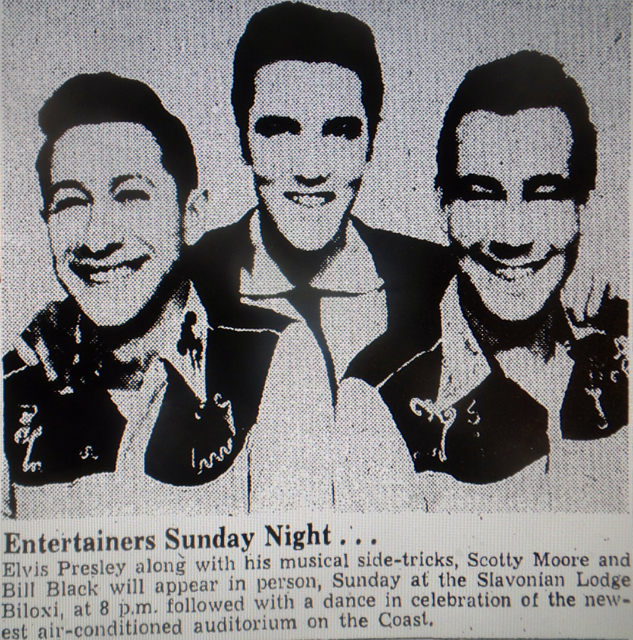
Elvis Presley (1935-1977), Sun Records recording artist and Louisiana Hayride particpant, appeared at the improved Slavonian Lodge on June 26, 1955. Louis Tremmel & Son had recently installed an air conditioning system making the Lodge the only air conditioned auditorium on the Coast. Improvements to the structure exceeded $30,000.(The Daily Herald, June 22, 1955, p. 7, June 23, 1955, p. 6, June 25, 1955)
The Times-Picayune, "The Day After-Festivities continue on as Yugoslavs at Biloxi honor their patron [St Stephen]", December 25, 1955, p. 5.
1959
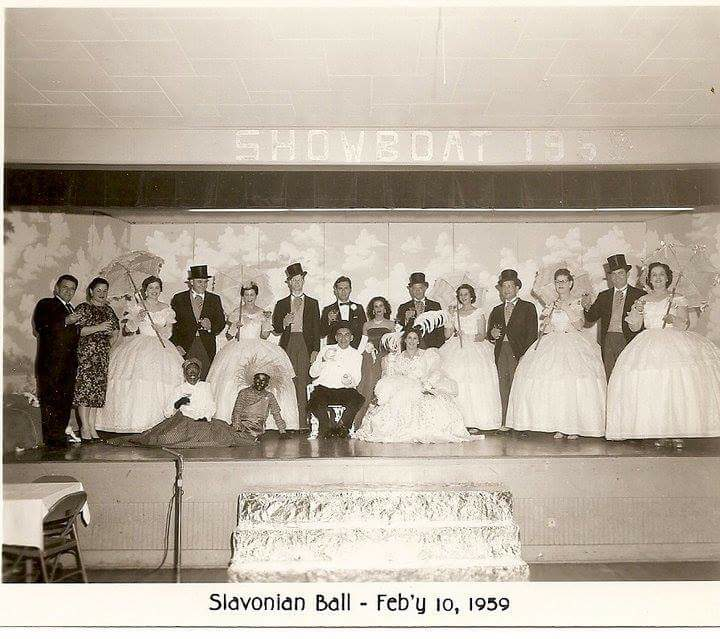
1974
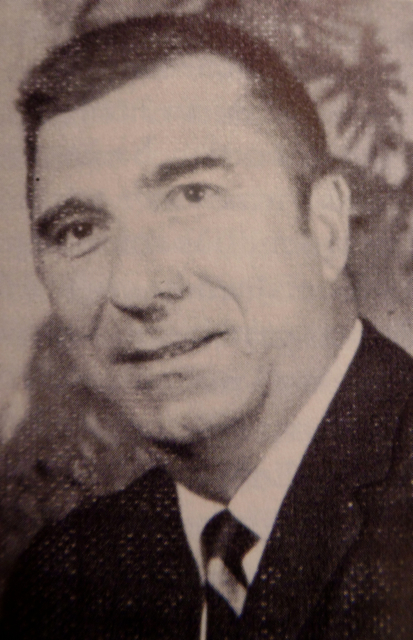
Milos M. Vujnovich published [Pelican Publishing Compmay of Gretna, Louisiana] Yugoslavians in Louisiana on the occaision of the Centennial of the United Slavonian Benevolent Association.
1999
The Sun Herald, "Slavonian men pose for posterity", December 18, 1999, p. A1.
2010
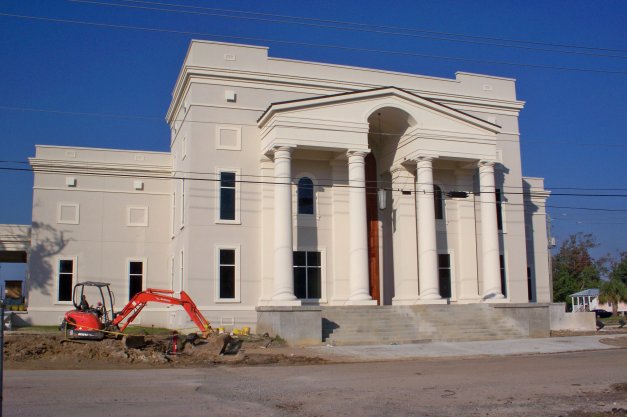
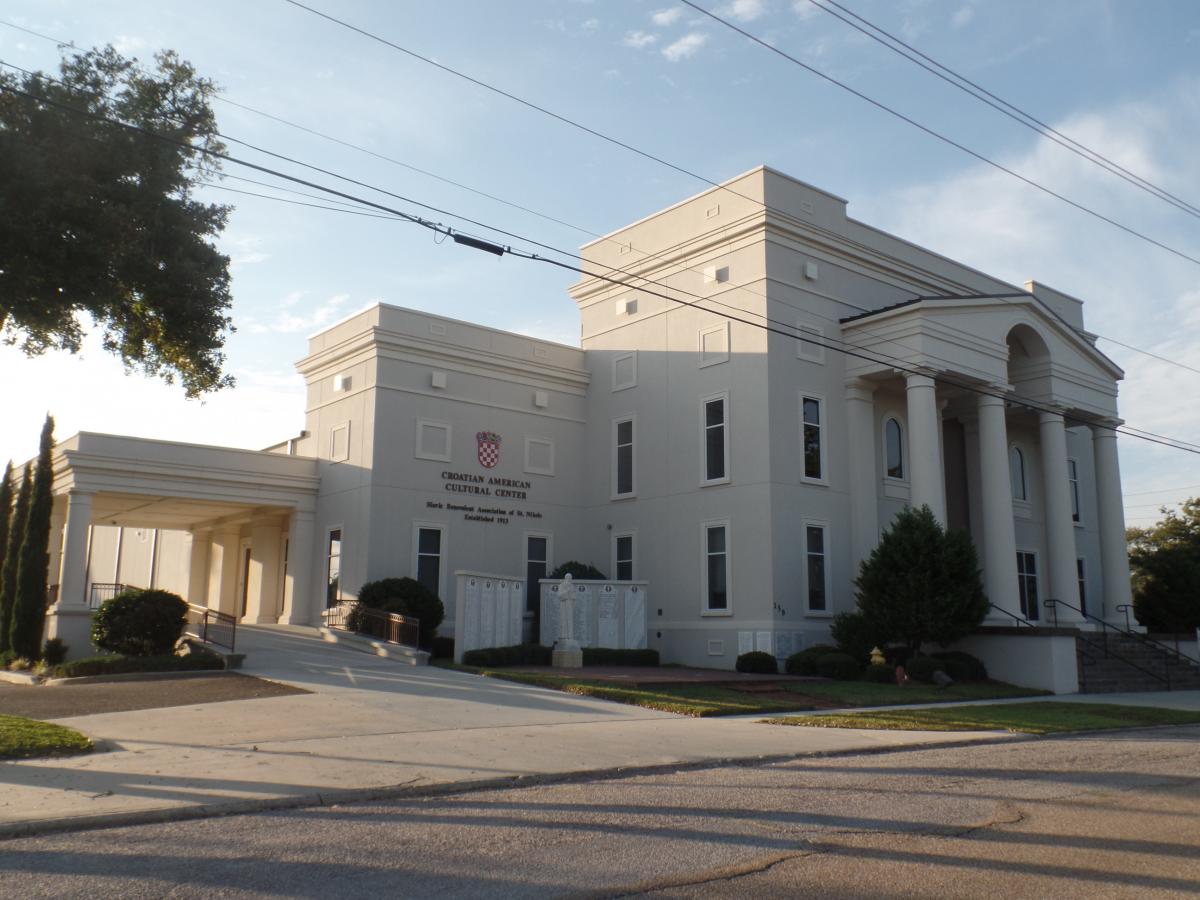
[images made November 2009 and October 2015]
The new $3 million Lodge of the Slavonian Benevolent Association of St. Nikolai, located near Howard Avenue and Oak Street, was dedicated on November 27th.(The Sun Herald, November 26, 2010, p. A2)
2011
Pusharatas are a sweet tradition.(The Sun Herald, December 24, 2011, p. A2)
2013
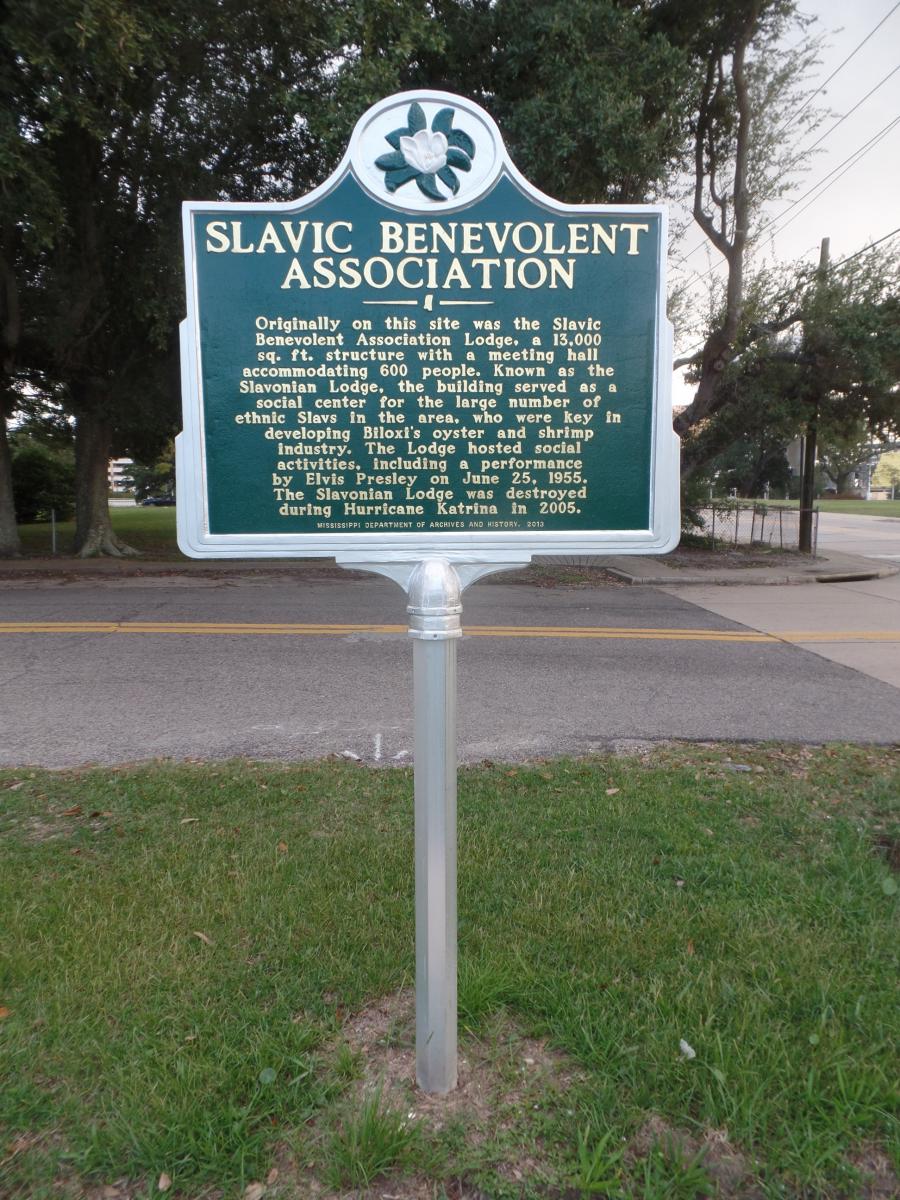

Historical marker placed at Myrtle and 1st Street by MDAH in 2013.
2014
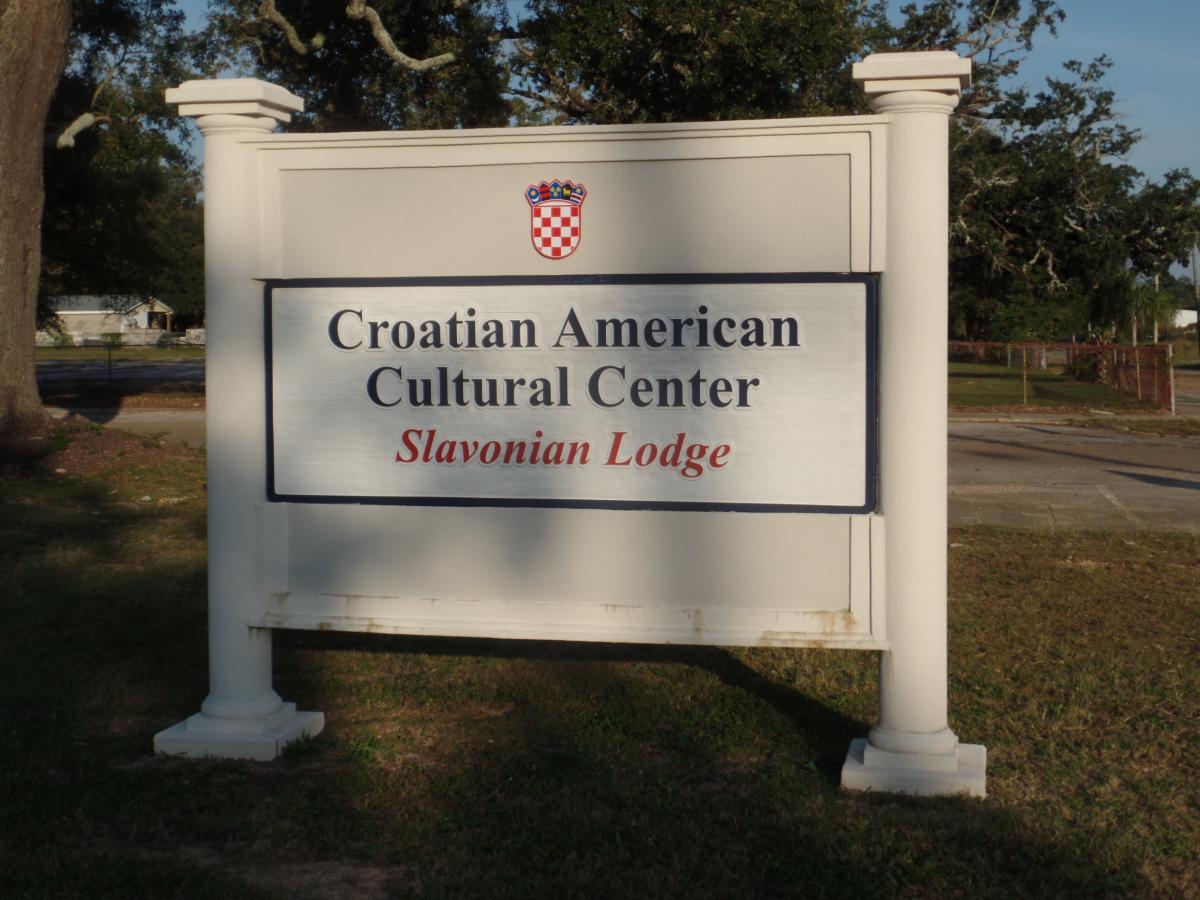
Corner of East Howard Avenue and
2015

Andrew 'FoFo' J. Gilich Jr.
Andrew "FoFo" J. Gilich Jr. and Winfield "Windy" Swetman III received 51 % of the vote in the April 28th Biloxi Mayoral election to replace former Mayor A.J. Holloway. In a runoff will be held on May 12, 2015, Mr. Gilich outpolled Mr. Swetman 4319 votes to 2914 votes and became Biloxi's new Mayor.(The Sun Herald, April 30, 2015, p. A-1 and May 13, 2015, p. A-1.)
2016

On August 6th, the Croatian-American Cultural Center, City of Biloxi and Dr. Gilbert Mason Jr were hosts to the Frank "Yankee" Barhanovich, 'The Music Mogul' and the 50th Anniversary of the August 5, 1966 Biloxi Municipal Stadium by James Brown.
------------------------------------------------------------------------------------------------------------------------------------------------------------------------------------
ARRIVALS FROM ZADAR
BULICH
Sam Bulich
Sam [Simeone] Bulich (1873-1955) was born at Zadar [Zara], Zadar County, Croatia on February 16, 1873. He left Trieste aboard Marguerite and arrived at Gulfport, Mississippi on November 2, 1905.[Declaration of Intention No. 534-Southern District-South Mississippi-May 27, 1918]
Sam Bulich settled at 336 Crawford Street in Biloxi and worked in the seafood industry as a fisherman. He died at the Biloxi Hospital on January 26, 1955. Sam was survived by a sister, Donica, in Yugoslavia and a nephew, Joseph Smolcich Sr. (1893-1967), Biloxi, and other relatives.
Funeral was from the O’Keefe Funeral Home with services at St. Michael’s Catholic Church followed by internment in the Biloxi Cemetery.
John Bulich
John Bulich (1877-1949) was the brother of Sam Bulich. He was born at Anbanasi, a village on the on the Zadar Peninsula, Croatia. John came to live with Sam on Crawford Street circa 1934. John appears to left his wife and three children in Croatia. He was a member of the Sea Food Workers and Gulf Coast Shrimpers and Oystermens Association. John worshipped at St. Michael’s Catholic Church and was a member of the Dalmatian Benevolent Society.
John Bulich died at 637 Crawford Street on January 5, 1949. He was survived by Sam Bulich and Joseph Smolich Sr. (1893-1967), his nephew. Funeral was from the O’Keefe Funeral Home with services at St. Michael’s Catholic Church followed by internment in the Biloxi Cemetery.[The Daily Herald, January 5, 1949, p. 3]
Funeral was from the O’Keefe Funeral Home with services at St. Michael’s Catholic Church followed by internment in the Biloxi Cemetery.
REFERENCES:
The Daily Herald, ‘John Bulich dies’, January 5, 1949.
The Daily Herald, ‘Sam Bulich dies’, November 27, 1955.
__________________________________________________________________________________
JOSEPH SMOLCICH
Joseph Smolcich [Josip Smolcic] (1893-1967) was born August 6, 1893 in Anbanasi, a village on the on the Zadar Peninsula, Zadar County, Croatia. He left Trieste, Italy on the Franz Joseph I and arrived at New York City on August 31, 1912.
Joseph Smolich married Frances Cvitanovich (1901-1979), a native of Milna, Brac, Split-Dalmatia County, Croatia, in Harrison County, Mississippi on May 22, 1916. They settled at 402 Oak Street in Biloxi. Francis was born September 19, 1901.(Declaration of Intention No. 840-Southern District, South Mississippi-March 12, 1927 and Harrison Co., Mississippi Circuit Court MRB 29, p. 38)
Joseph Smolcich and Francis Cvitanovich Smolich were the parents of at least seven children: Matilda Smolcich (b. 1920) m. Raymond C. Barry (1905-1988); Joseph 'Smoky Joe' A. Smolcich (1922-2010) m. Anna Kopszywa (1927-2010); Vincent L. Smolcich (1925-1981) m. Aurora Marie Saujon (1924-2007), the daughter of Robert Saujon (1865-1944) and Mary McCaleb (1897-1937); Steve Anthony Smolcich (1927-2013) m. Patricia Lee Wilson; ; Mary Rita 'Melrita' Smolcich m. Marvin Lee Raesner; Samuel Dominick Smolcich (1934-2006) m. Vinnie Elva Seymour; and John Anthony Smolcich (1937-2001) m. Jeanet M. Smolcich. The Smolcich family started the Biloxi Seafood Company, the Roxy Theatre at 1430 East Howard Avenue, the Roxy Restaurant and owned much rental property on Point Cadet in East Biloxi.(The Sun Herald, October 12, 2010, p. A4)
REFERENCES:
The Daily Herald, "Smolcich-Wilson", January 2, 1950, p. 6.
The Daily Herald, “Frances C. Smolcich”, February 13, 1979.
The Daily Herald, “Vincent Smolcich”, July 28?, 1981.
The Sun Herald, “Aurora Marie Saujon Smolich”, April 5, 2002.
The Sun Herald, “John Anthony Smolich”, August 31, 2001.
The Sun Herald, "Joseph 'Smokey Joe' Smolcich", October 11, 2010, p. A6.
The Sun Herald, "Smolcich lived as 'Mr. Biloxi'", October 12, 2010, p. A4.
The Sun Herald, "Steven Anthony 'Steve' Smolcich Sr.", July 14, 2013.
- Printer-friendly version
- 5560 views